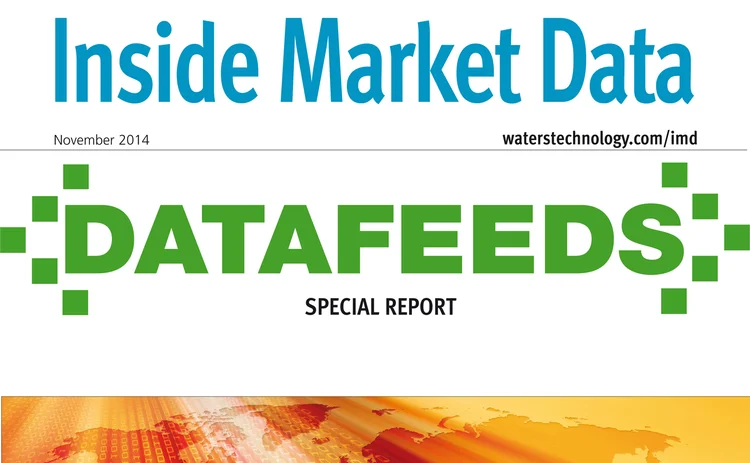Datafeeds Special Report

CLICK HERE TO DOWNLOAD THE FULL REPORT
Different Feeds for Different Folks
Over the past 15 years, the datafeeds landscape has changed beyond recognition. Once the preserve of only the largest firms with the most demanding requirements in terms of volume and performance, with most capital markets participants relying on terminals to meet their data requirements, the efficiency and speed advantages of both consolidated and direct feeds won over users at large and small firms alike.
On the direct feed side, this was largely driven by two factors: trading firms wanting faster and direct sources of data to support evolving algorithmic trading operations, and exchanges looking for new revenues, bypassing traditional consolidators with their own direct feed infrastructures. And despite these efforts, consolidated feed use has also grown as trading operations become more globalized and firms began demanding access to markets where direct feeds are either impractical or simply don't exist.
But if speed was the driving factor for feeds, the current focus is on flexibility and performance, where "performance" covers a multitude of factors beyond just speed, including reliability, capacity management and cost. So firms must not only invest in high-performance infrastructures to handle these datafeeds, but also in sophisticated monitoring systems to measure speed, uptime and other factors─though unlike in the past, when these were used by small business units running alongside enterprise systems, high performance is now the standard. "Speed has become an expectation, not a driver," says Adam Honore, chief executive of financial technology business strategy consultancy MarketsTech LLC.
However, over the same period, attrition and mergers have meant that the once-booming market for data distribution platforms and ticker plants has shrunk significantly, with much of this infrastructure business consolidating around a de facto incumbent, and only a few smaller technology companies providing competing platforms─though usually with limited capabilities.
Increased data availability has inevitably led to commoditization, and so in addition to datafeeds, firms are now looking at analytics that can deliver additional value and insight into the raw data. And with more analytics being presented via apps to serve the needs of an increasingly mobile workforce, new delivery mechanisms, APIs and cloud data marts are a logical next step for many data consumers─though participants in this report's Q&A say these will coexist with, rather than replace, the current generation of datafeed solutions.
Only users who have a paid subscription or are part of a corporate subscription are able to print or copy content.
To access these options, along with all other subscription benefits, please contact info@waterstechnology.com or view our subscription options here: https://subscriptions.waterstechnology.com/subscribe
You are currently unable to print this content. Please contact info@waterstechnology.com to find out more.
You are currently unable to copy this content. Please contact info@waterstechnology.com to find out more.
Copyright Infopro Digital Limited. All rights reserved.
As outlined in our terms and conditions, https://www.infopro-digital.com/terms-and-conditions/subscriptions/ (point 2.4), printing is limited to a single copy.
If you would like to purchase additional rights please email info@waterstechnology.com
Copyright Infopro Digital Limited. All rights reserved.
You may share this content using our article tools. As outlined in our terms and conditions, https://www.infopro-digital.com/terms-and-conditions/subscriptions/ (clause 2.4), an Authorised User may only make one copy of the materials for their own personal use. You must also comply with the restrictions in clause 2.5.
If you would like to purchase additional rights please email info@waterstechnology.com
More on Data Management
Everyone wants to tokenize the assets. What about the data?
The IMD Wrap: With exchanges moving market data on-chain, Wei-Shen believes there’s a need to standardize licensing agreements.
FIX Trading Community recommends data practices for European CTs
The industry association has published practices and workflows using FIX messaging standards for the upcoming EU consolidated tapes.
TCB Data-Broadhead pairing highlights challenges of market data management
Waters Wrap: The vendors are hoping that blending TCB’s reporting infrastructure with Broadhead’s DLT-backed digital contract and auditing engine will be the cure for data rights management.
CME, LSEG align on market data licensing in GenAI era
The two major exchanges say they are licensing the use case—not the technology.
Data infrastructure must keep pace with pension funds’ private market ambitions
As private markets grow in the UK, Keith Viverito says the infrastructure that underpins the sector needs to be improved, or these initiatives will fail.
AI enthusiasts are running before they can walk
The IMD Wrap: As firms race to implement generative and agentic AI, having solid data foundations is crucial, but Wei-Shen wonders how many have put those foundations in.
Jump Trading spinoff Pyth enters institutional market data
The data oracle has introduced Pyth Pro as it seeks to compete with the traditional players in market data more directly.
50% of firms are using AI or ML to spot data quality issues
How does your firm stack up?








